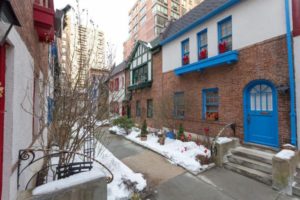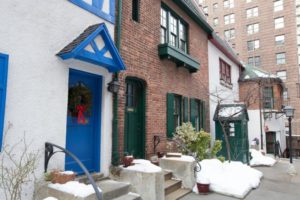
Pomander Walk*
*I brazenly lurked outside here a questionable amount of times before finally getting in
A few weeks ago a close friend of mine and I were sneaking to the front of a fairly high profile event where we did not belong. I pulled the reins as we rubbed elbows with the owner of the New York Jets (forecasting that conversation, “Hi I’m Liz, and I’m a Leo with a propensity for soft rind cheeses”) and my friend told me the first lesson her parents taught her after don’t steal/don’t cheat/don’t kill anyone:
“It’s easier to ask forgiveness than it is to get permission”
So three words I would never use to describe myself: Subtle, Reticent or Incurious.
I have a serious issue where if I’m faintly intrigued by something, I’ll shamelessly get as close to it as possible. This is why my father has made me watch “Taken” with him well over a dozen times. A year ago, I saw an article on Untapped Cities about this hidden UWS jewel-box enclave, Pomander Walk, and immediately became obsessed with this Diagon Alley-esque escape from the monotony of Manhattan’s high rises. Not ready to settle for the complacency of a quick peak through the gates, I parked my blonde self at the entrance and after countless futile attempts, I finally bumped into the right resident who kindly gave me a full tour and low down on the history of my future home:









Pomander Walk was the vision of a New Yorker by the name of Thomas Healy, an Irish Immigrant and Restaurateur who capitalized on the low real estate prices of the Upper West Side in the early 1900’s when in 1920, he purchased the vacant lot where the development now stands. Healy, a lover of the theater, fashioned the aesthetics of the development to replicate the quaint, cozy look of the stage design for the wildly popular Broadway show, “Pomander Walk.” The show was inspired by a English town, Chiswick, which served as further inspiration for Healy. The units were initially designed to serve as residences for visiting actresses and actors; “light housekeeping” homes, as still seen in the current floor-plans’ tiny kitchens.
Pomander Walk is relatively hidden, with its main entrance tucked away on the north side of 94th Street between Broadway and West End Avenue. In 1983, the neighborhood was designated a landmark, which thankfully means the Walk looks exactly how it did 100 years ago. Since Pomander Walk is a Co-op and the inhabitants are extremely protective of their own little “Brigadoon”, the vetting process to purchase and sublease is extremely strict. Once accepted into this secret society, one immediately joins the residents of the 27 buildings in forming a very tight and quite social community. The folk of Pomander Walk are much different than those you will find in any new, flashy development; those who want cozy and quaint are starkly diverse from those drawn to expansive and ostentatious.
One of the most interesting things about Pomander Walk is how it proves that mass-produced housing can still be visually engaging, achieved through non-functional details situated on a superficial layer. Most of the captivating Tudor details are imitation, using wood-wrapped steel on the facades. This method allowed for the original houses to cost only $2,950. While the design may be inexpensive, its effects are invaluable, truly allowing the olden times to transported to the heart of the modern world. The backdrop of the high rise apartment buildings nearby only make this little narrow Walk all the more unique in its setting.
Brb, gtg scrub my social media footprint and send love notes to their coop board.
Recent listings:
226 West 95th Street, Apt 8 – 3 bedroom, 2.5 bathroom for $2,299,000
274 West 95th Street – 5 bedroom, 3 bathroom for $2,095,000
265 West 94th, Apt 7 – 2 bedroom, 1 bathroom for $800,000